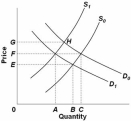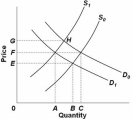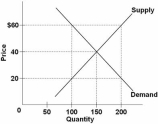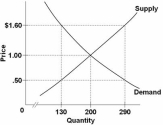A) price ceiling.
B) price floor.
C) equilibrium price.
D) fair price.
F) A) and C)
Correct Answer

verified
Correct Answer
verified
Multiple Choice
 Refer to the above table.Suppose that demand is represented by columns (3) and (2) and supply is represented by columns (3) and (5) .If the price were artificially set at $9:
Refer to the above table.Suppose that demand is represented by columns (3) and (2) and supply is represented by columns (3) and (5) .If the price were artificially set at $9:
A) the market would clear.
B) a surplus of 20 units would occur.
C) a shortage of 20 units would occur.
D) demand would change from columns (3) and (2) to columns (3) and (1) .
F) B) and D)
Correct Answer

verified
Correct Answer
verified
Multiple Choice
 Refer to the above diagram,which shows demand and supply conditions in the competitive market for product X.If the initial demand and supply curves are D0 and S0,equilibrium price and quantity will be:
Refer to the above diagram,which shows demand and supply conditions in the competitive market for product X.If the initial demand and supply curves are D0 and S0,equilibrium price and quantity will be:
A) 0F and 0C respectively.
B) 0G and 0B respectively.
C) 0F and 0A respectively.
D) 0E and 0B respectively.
F) B) and D)
Correct Answer

verified
Correct Answer
verified
Multiple Choice
 Refer to the above table.In relation to column (3) ,a change from column (1) to column (2) would mostly likely be caused by:
Refer to the above table.In relation to column (3) ,a change from column (1) to column (2) would mostly likely be caused by:
A) reduced taste for the good.
B) an increase in input prices.
C) consumers expecting that prices will be higher in the future.
D) government subsidizing production of the good.
F) A) and B)
Correct Answer

verified
Correct Answer
verified
True/False
The rationing function of prices refers to the fact that government must distribute any surplus goods that may be left in a competitive market.
B) False
Correct Answer

verified
Correct Answer
verified
Multiple Choice
Suppose that corn prices rise significantly.If farmers expect the price of corn to continue rising relative to other crops,then we would expect:
A) the supply of ethanol,a corn-based product,to increase.
B) consumer demand for wheat to fall.
C) the supply to increase as farmers plant more corn.
D) the supply to fall as farmers plant more of other crops.
F) A) and C)
Correct Answer

verified
Correct Answer
verified
Multiple Choice
Other things equal,if the price of a key resource used to produce product X falls,the:
A) product supply curve of X will shift to the right.
B) product demand curve of X will shift to the right.
C) product supply curve of X will shift to the left.
D) product demand curve of X will shift to the left.
F) A) and D)
Correct Answer

verified
Correct Answer
verified
Multiple Choice
 Refer to the above diagram,which shows demand and supply conditions in the competitive market for product X.Given D0,if the supply curve moved from S0 to S1,then:
Refer to the above diagram,which shows demand and supply conditions in the competitive market for product X.Given D0,if the supply curve moved from S0 to S1,then:
A) supply has increased and equilibrium quantity has decreased.
B) supply has decreased and equilibrium quantity has decreased.
C) there has been an increase in the quantity supplied.
D) supply has increased and price has risen to 0G.
F) None of the above
Correct Answer

verified
Correct Answer
verified
Multiple Choice
If an effective price ceiling is placed on hamburgers,then:
A) the quantity demanded will exceed the quantity supplied.
B) a black market for hamburgers may evolve.
C) consumers may want government to ration hamburgers.
D) All of these are likely outcomes.
F) B) and C)
Correct Answer

verified
Correct Answer
verified
Multiple Choice
In the past few years the demand for donuts has greatly increased.This increase in demand might best be explained by:
A) an increase in the cost of making donuts.
B) an increase in the price of coffee.
C) consumers expecting donut prices to fall.
D) a change in buyer tastes.
F) A) and B)
Correct Answer

verified
Correct Answer
verified
Multiple Choice
Which of the following statements is correct?
A) If demand increases and supply decreases,equilibrium price will fall.
B) If supply increases and demand decreases,equilibrium price will fall.
C) If demand decreases and supply increases,equilibrium price will rise.
D) If supply decreases and demand remains constant,equilibrium price will fall.
F) C) and D)
Correct Answer

verified
Correct Answer
verified
Multiple Choice
The term "quantity demanded":
A) refers to the entire series of prices and quantities that comprise the demand schedule.
B) refers to a situation in which the income and substitution effects do not apply.
C) refers to the amount of a product that will be purchased at some specific price.
D) means the same thing as demand.
F) A) and C)
Correct Answer

verified
Correct Answer
verified
Multiple Choice
A decrease in the demand for recreational fishing boats might be caused by an increase in the:
A) income of sports fishers.
B) price of outboard motors.
C) size and number of fish available.
D) price of sailing boats.
F) All of the above
Correct Answer

verified
Correct Answer
verified
Multiple Choice
 Refer to the above diagram.If this is a competitive market,price and quantity will move toward:
Refer to the above diagram.If this is a competitive market,price and quantity will move toward:
A) $60 and 100,respectively.
B) $60 and 200,respectively.
C) $40 and 150,respectively.
D) $20 and 150,respectively.
F) A) and D)
Correct Answer

verified
Correct Answer
verified
Multiple Choice
 Refer to the above diagram.A surplus of 160 units would be encountered if price was:
Refer to the above diagram.A surplus of 160 units would be encountered if price was:
A) $1.10,that is,$1.60 minus $.50.
B) $1.60.
C) $1.00.
D) $.50.
F) All of the above
Correct Answer

verified
Correct Answer
verified
Multiple Choice
If the demand curve for product B shifts to the right as the price of product A declines,then:
A) both A and B are inferior goods.
B) A is a superior good and B is an inferior good.
C) A is an inferior good and B is a superior (or "normal") good.
D) A and B are complementary goods.
F) B) and D)
Correct Answer

verified
Correct Answer
verified
Multiple Choice
A demand curve:
A) shows the relationship between price and quantity supplied.
B) indicates the quantity demanded at each price in a series of prices.
C) graphs as an upsloping line.
D) shows the relationship between income and spending.
F) None of the above
Correct Answer

verified
Correct Answer
verified
Multiple Choice
In which of the following statements are the terms "demand" and "quantity demanded" used correctly?
A) When the price of ice cream rose,the demand for both ice cream and ice cream toppings fell.
B) When the price of ice cream rose,the quantity demanded of ice cream fell and the demand for ice cream toppings fell.
C) When the price of ice cream rose,the demand for ice cream fell and the quantity demanded of ice cream toppings fell.
D) None of these statements uses the terms correctly.
F) A) and C)
Correct Answer

verified
Correct Answer
verified
True/False
Toothpaste and toothbrushes are substitute goods.
B) False
Correct Answer

verified
Correct Answer
verified
Multiple Choice
With a downsloping demand curve and an upsloping supply curve for a product,an increase in consumer income will:
A) increase equilibrium price and quantity if the product is a normal good.
B) decrease equilibrium price and quantity if the product is a normal good.
C) have no effect on equilibrium price and quantity.
D) reduce the quantity demanded but not shift the demand curve.
F) None of the above
Correct Answer

verified
Correct Answer
verified
Showing 61 - 80 of 179
Related Exams